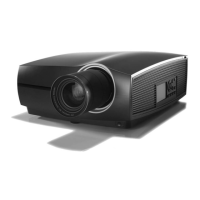R5906852 /09 F8028
Going from READY to ECO standby
If ECO Standby mode is enabled in the service menu (refer to the section "GUI - system settings/Standby
ECO", in User Guide) the projector will automatically go to ECO standby mode after a time-out (default 15
minutes). All electronics (including fans, pumps,...) go down except for a very small wake up controller. The
Power on/off button will FLASH WHITE every second.
Another way to switch in ECO mode (when you are in READY mode) is press and hold the Power on/off
button on the projector for 3 seconds, or press the Power Off button on the remote control.
And finally, a JSON command (Go to ECO) could also be send to make the projector turn in to ECO mode.
Going from ECO to ON
Press the Power on/off button on the projector or the Power On button on the remote control. The projector
goes from ECO directly to ON. The projector will go through the same booting phase as on power plugging,
then do the transition from READY to ON. Of course startup-time will be longer then from READY to ON.
An ASCII command (Powr1) could also be send via RS232 to make the projector turn in to ON mode.
Wake on LAN (WOL)
Wake-on-LAN (WOL), the standard ethernet network command, can be used to awakened or to turn on the
projector by network message.
Used alone, the WOL command allows to switch in READY mode. A JSON command must be performed in
addition to make the projector turn in to ON mode:
1. Send WOL.
2. Wait for connection to façade/prospector (the unit does provide feedback when it’s ready).
3. Wait for ready state.
4. Sleep 5 seconds.
5. Send JSON “power on” command (to switch in ON mode).
2.6 Status overview
Description
Once the projector is started, go to Status menu to get an overview of parameters such as :
• Chosen source
• Current resolution and refresh rate
• Device serial number and article number
• Current firmware version and model name
• Current illumination (in percentage)
• Lamp runtime in hours
• Chosen communication method and IP address (if connected)
• Warp status
• Environmental temperature
Getting Started

